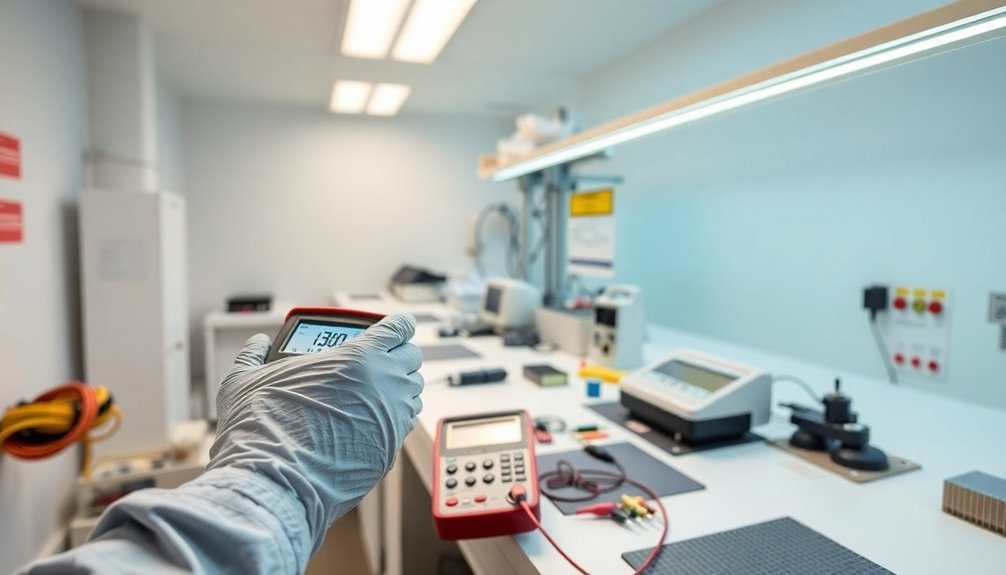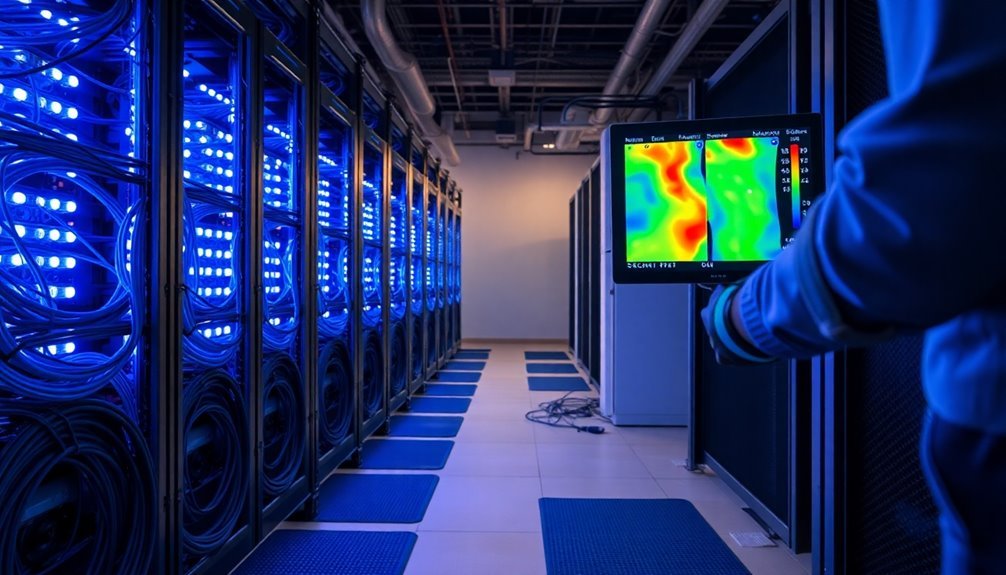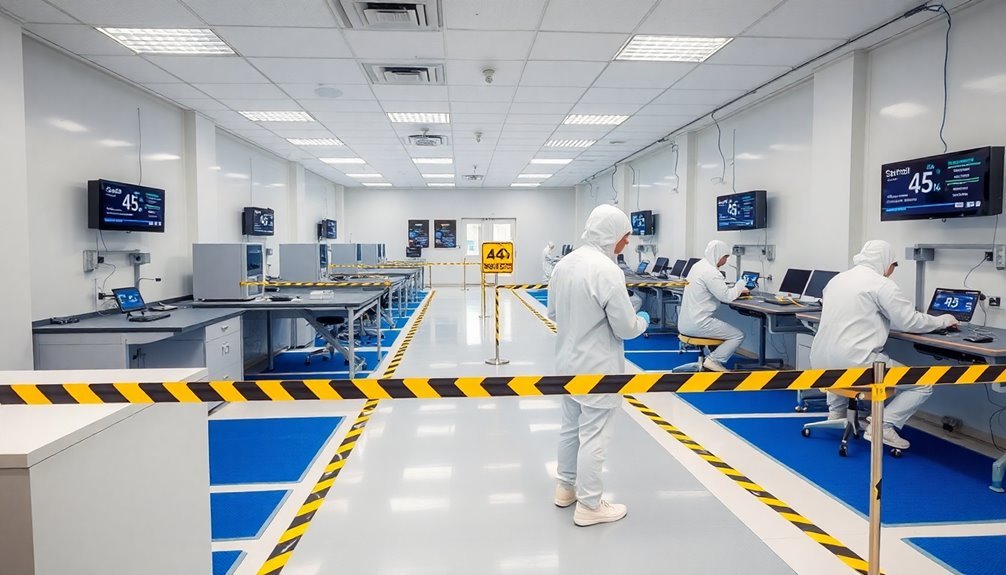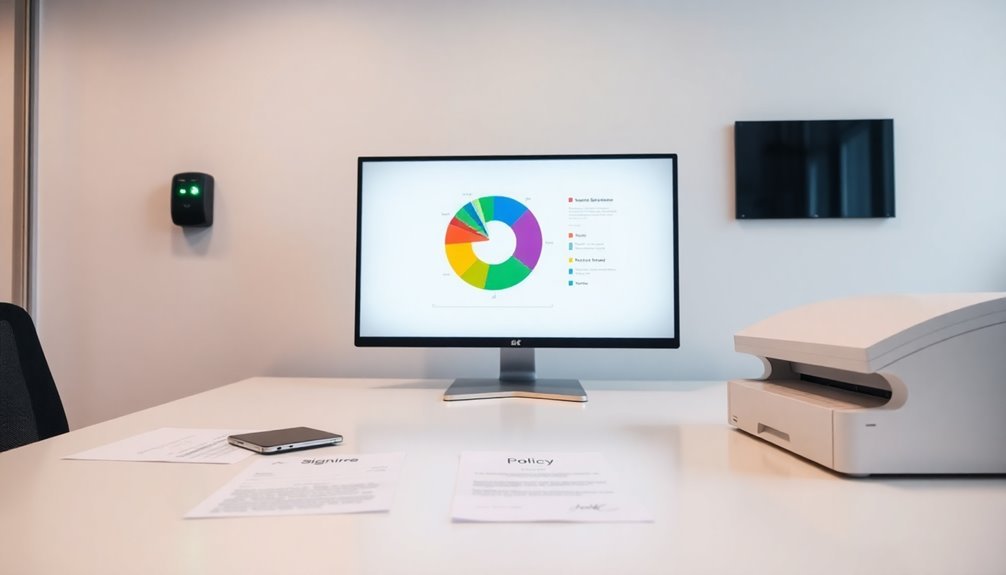To make your static control policy successful, you'll need strong leadership buy-in and clear organizational commitment from the top down. Build a solid training foundation with role-specific modules and diverse learning methods, while establishing precise measurement protocols and monitoring systems. You'll want to prioritize critical process areas and guarantee compliance through regular audits and verification processes. Focus on maintaining effective communication channels and feedback loops throughout your organization. Set up sustainable compliance methods that adapt to changing conditions. The right combination of these elements will release your program's full potential.
Gaining Leadership Buy-In

Securing leadership buy-in stands as the cornerstone of any successful ESD control policy implementation. You'll need to communicate clear objectives to top management, highlighting potential ROI of up to 1,000% annually while emphasizing improvements in quality, productivity, and customer satisfaction.
Support your case with concrete data and case studies that demonstrate the program's value. For example, organizations like AT&T, Lucent Technologies, and IBM have shown significant returns on investment by implementing ESD control programs, with ROI exceeding five to one within six months. Two-way dialogue with leadership is essential for addressing concerns and gathering valuable input.
You must strategically involve your leadership team through one-on-one interviews to understand their concerns and perspectives. Facilitate group discussions to resolve disagreements and guarantee alignment with strategic objectives. It's vital to assign specific program elements to different leaders, making them personally invested in the outcome.
Develop an extensive plan that includes technical requirements and specific goals, establishing an ESD coordinator or team for oversight. This ESD coordinator is responsible for developing, budgeting, and administering the program, as well as serving as the company's internal ESD consultant to all ESD control program areas.
You'll want to conduct thorough assessments of your organization's facilities and processes to identify improvement areas. After completing your assessment, you can begin to develop and document your ESD control program plan. The plan should cover the scope of the program and include the tasks, activities, and procedures necessary to protect the ESD-sensitive items at or above the ESD sensitivity level chosen for the plan.
To maintain momentum, implement regular audits and reviews while providing consistent feedback to both employees and management. The ESD coordinator should ensure ongoing verification and compliance with the control program, including continuously measuring the leakage resistances of production and workplace equipment, floors, machines, and systems. Training employees on ESD protection is also a critical task.
To justify the program's ongoing value and secure sustained commitment from your leadership team, continuously track and communicate the ROI. Prepare and distribute written procedures and specifications so that all departments have a clear understanding of what is to be done. Fully documented procedures will help meet the administrative and technical elements of relevant standards such as ANSI/ESD S20.20 or IEC 61340-5-1.
Building Strong Training Foundations
A strong ESD training foundation requires a thorough approach that covers all personnel who handle sensitive components. You'll need to develop specific training modules for different job roles while maintaining consistency across your organization's locations and departments.
Make sure you've got a centralized repository of educational materials and a knowledgeable expert available to address questions. Implementing formal audit processes helps prevent problems before they occur.
You should implement diverse training methods, including live instruction, videos, and interactive computer-based programs. Don't forget to incorporate practical demonstrations that show real ESD events and their consequences.
Your training program must include testing and certification to verify that employees retain the information they've learned.
Set up a system to track when your staff needs retraining or recertification. You'll want to share productivity data that demonstrates how effective ESD controls boost performance.
Keep improving your program by gathering feedback and analyzing results regularly. Remember to integrate your training plan into your overall quality system and guarantee it aligns with your written ESD control plan.
Make compliance verification a priority to maintain program effectiveness and protect your sensitive components.
Establishing Clear Measurement Protocols

When implementing effective ESD control measures, you'll need clear measurement protocols to verify their performance. Start by establishing consistent benchmarks for resistance measurements across your work surfaces, using probes placed at least 25 cm apart and 5 cm from edges. You'll want to confirm all point-to-point readings remain below 1×10⁹ Ω.
For thorough testing, you'll need to measure between multiple points: tabletop to shelf, work surface to ESD floor, and equipment to common point ground. The resistance range should be verified with ESD meter kits for accurate results.
Always use properly calibrated tools, including handheld electrostatic field meters for static surveys and point-to-point resistance testers for surface measurements. Don't forget to maintain clean conditions and control relative humidity for accurate readings.
Set up a regular testing schedule that covers all ESD-critical areas. You'll need to document every measurement and maintain detailed records of any issues encountered.
When cleaning surfaces, use only ESD-compatible detergents to avoid creating insulative layers. By following these protocols consistently, you'll create a reliable system for monitoring your ESD control measures and quickly identifying any areas that need attention.
Prioritizing Critical Process Areas
Systematic identification of high-priority areas builds upon your measurement protocols to enhance static control effectiveness. You'll need to focus on processes that directly impact quality and safety while taking into account regulatory requirements like GDPR and HIPAA. Evaluate both immediate and cascading effects on your operations to determine which areas demand the most rigorous control measures. Control limits based on 3-sigma calculations provide statistical boundaries for identifying process deviations that warrant immediate attention.
| Priority Level | Process Characteristics | Required Actions |
|---|---|---|
| Critical | Direct quality/safety impact | Daily monitoring |
| High | Regulatory compliance | Weekly checks |
| Medium | Operational efficiency | Bi-weekly review |
| Low | Support functions | Monthly audit |
| Minimal | Auxiliary processes | Quarterly assessment |
Your risk assessment should incorporate multiple frameworks to provide thorough coverage. You'll want to take into account financial implications, operational disruptions, and reputational damage when setting priorities. Don't forget to analyze historical incidents and breach patterns to inform your decisions. As processes evolve, you must continuously monitor and adjust your control limits. Remember to integrate feedback from past incidents and maintain flexibility in your approach to address emerging risks and changing regulatory requirements.
Implementing Effective Monitoring Systems

The successful implementation of monitoring systems requires integrating four key components: continuous tracking, dynamic thresholds, ESD monitoring, and network integration.
You'll need real-time tracking to stream information from your monitoring devices, with color-coded facility maps and summary reports that help you quickly identify issues. Your system should enable remote adjustments of monitor limits and provide immediate alarm notifications when problems arise. Web app dashboards allow facility-wide status monitoring from any location.
To minimize false alarms, you'll want dynamic thresholds that analyze historical performance data. These adaptive mechanisms require about 5 hours of initial setup and up to 15 days of historical data to establish reliable baselines. They'll help you combine dynamic thresholds for warnings with static thresholds for critical alerts.
Dynamic thresholds are particularly beneficial as they are calculated by anomaly detection algorithms and continuously updated using historical data. This approach helps in detecting rates of change, trends, and correlations between variables, reducing false positives and providing a more accurate representation of the system's health.
Your ESD monitoring equipment should include continuous monitoring systems for wrist straps and worksurfaces, available in both single and dual wire configurations. These systems detect even split-second failures that periodic testing might miss.
Finally, integrate your monitoring into your network infrastructure with customizable dashboards that provide complete visibility. You'll want to establish clear baselines, conduct regular audits, and maintain proactive monitoring to guarantee thorough coverage across your facility.
Developing Employee Feedback Channels
To effectively manage static control feedback from your team members, you'll need to establish clear communication pathways, ensuring information flows both up and down the organizational hierarchy.
Setting response time standards for feedback helps maintain accountability and shows employees their input matters in the static control process.
Regular feedback analysis helps identify emerging trends and patterns in static control challenges across the organization.
Implement actionable input methods, such as digital forms or scheduled check-ins, that make it easy for employees to report static control issues and suggest improvements to existing protocols.
Clear Communication Pathways
Effective employee feedback channels serve as vital arteries in any static control policy's success. To establish clear communication pathways, you'll need to implement diverse channels that accommodate all employees' preferences and work schedules.
By utilizing both digital platforms and physical feedback boxes, you're ensuring maximum accessibility and participation. This approach helps break down silos and fosters transparency across all organizational levels.
You should focus on creating a systematic approach to feedback collection. This means regularly monitoring all channels, categorizing submissions based on urgency, and preparing concise summaries for management review.
It's vital to integrate interactive tools like polls and comments that enable real-time engagement and quick responses.
To maintain momentum, you'll want to foster a culture that actively recognizes and rewards valuable feedback. When employees see their input directly influencing organizational decisions, they're more likely to continue participating.
Make sure you're implementing both anonymous and identified feedback mechanisms to accommodate different comfort levels.
Don't forget to close the feedback loop by acting on the input received and sharing results regularly. By incorporating feedback into surveys and performance reviews, you're creating a thorough system that supports your static control policy's effectiveness.
Response Time Standards
Building on clear communication pathways, response time standards play a fundamental role in maintaining dynamic feedback channels. You'll need to establish systematic approaches that guarantee swift responses to employee feedback while balancing both immediate and long-term engagement strategies. Similar to process safety time, calculating appropriate response windows is crucial for preventing critical failures.
You should implement continuous listening platforms that enable quick identification of emerging issues. Set up pulse surveys for immediate actions, and complement them with interval surveys to measure specific topics over time.
Your feedback mechanisms must include both formal and informal channels, allowing for thorough coverage through downward, upward, and multidirectional communication.
To maintain effectiveness, you'll want to monitor performance through engagement metrics and satisfaction scores. Don't rely solely on quantitative data – incorporate qualitative insights through focus groups to gain deeper understanding of employee experiences.
Remember to develop action plans based on the feedback you receive, and guarantee leadership remains committed to implementing improvements.
Your response time standards should follow ISO guidelines where applicable, particularly for urgent matters. By establishing balanced feedback loops, you'll create stability in your static control policy while promoting continuous improvement through timely engagement and systematic monitoring.
Actionable Input Methods
An organization's success in gathering employee feedback hinges on developing diverse, accessible input channels that match workforce needs. You'll need to evaluate your organization type, work environment, and employees' technology access when implementing feedback mechanisms.
Create a mix of formal and informal channels that accommodate different comfort levels and schedules.
Make sure your feedback systems operate both during and after work hours, and implement multiple methods ranging from casual conversations to structured surveys. You'll want to assign specific personnel to monitor and respond to input promptly, demonstrating that you value employee contributions.
When employees see their suggestions being implemented, they're more likely to continue participating in the feedback process.
Establish consistent two-way communication patterns and promote your feedback channels throughout the organization. Don't forget to maintain transparency about how you're using employee input to shape decisions.
Create a continuous dialogue by implementing negative, positive, and balancing feedback loops that help you adapt and improve. Regular collection and analysis of feedback prevents employee frustration and disengagement while fostering a culture of open communication and collaborative problem-solving.
Creating Sustainable Compliance Methods

You'll need to establish regular audits and verification processes to maintain your static control program's effectiveness over time.
Consistently documenting these verification steps creates a clear trail of compliance and helps identify areas that need improvement.
Your ongoing employee training program reinforces control standards and keeps team members current with the latest static control protocols.
Regular Audits Drive Compliance
Regular audits serve as the backbone of any successful static control policy, driving consistent compliance through systematic verification and improvement.
You'll need to conduct these audits frequently, often monthly, using targeted sampling techniques to assess your ESD control measures effectively. Your audit program should encompass different types of evaluations, including program management, quality process checking, and workplace inspections.
When you're implementing your audit strategy, you'll want to focus on both compliance verification and performance monitoring. Your audits will help you identify potential problems before they escalate, allowing you to take immediate corrective action.
By tracking trends and analyzing results, you can determine when to adjust audit frequency or implement additional training.
You'll find that regular audits deliver multiple benefits to your static control program. They'll help you improve yields, boost productivity, and optimize resource allocation.
Once you've completed each audit, it's essential to implement corrective actions promptly. Document your findings thoroughly and maintain detailed records for quality control purposes.
Documenting Verification Processes
Documentation provides the foundation for sustainable static control compliance, guaranteeing your verification processes remain consistent and traceable over time.
You'll need to develop a clear project plan that outlines your verification techniques and compliance methods, identifying potential gaps in your current processes and addressing them systematically.
Start by implementing static testing procedures that evaluate your control measures without active execution. You should include various review types, from informal walkthroughs to structured peer reviews and inspections. These reviews help you detect issues early, from initial requirements through to source code implementation.
When documenting your static control policies, you must align them with industry standards like ANSI/ESD S20.20. Include detailed descriptions of your static mitigation strategies and guarantee they're suitable for your specific application.
You'll want to integrate automated static analysis tools to enhance quality control while maintaining proper documentation of all control measures.
Establish a reporting-based approach to track your sustainability performance, and keep your documentation current with regular updates.
This thorough documentation strategy helps you maintain compliance while avoiding legal complications that could arise from incorrect implementation.
Training Reinforces Control Standards
Effective static control standards rely heavily on thorough training programs that reinforce proper procedures and behaviors. You'll need to guarantee your training covers extensive content, including static electricity fundamentals, specific procedures, and the benefits of your ESD control program.
By developing tailored modules for different job disciplines and educational levels, you're more likely to achieve meaningful engagement and understanding across your organization.
To create sustainable compliance, you'll want to move beyond static approaches and embrace a dynamic training strategy. This means continuously reviewing and improving your programs while adapting to technological changes and employee feedback.
You should also consider cultural differences when delivering training across various groups and countries, guaranteeing your message resonates effectively with all participants.
Your training program must be tied to measurable performance goals that verify employee understanding and implementation. Remember to map your regulatory exposure and engage with suppliers to strengthen your compliance framework.
Managing Equipment Standards
Maintaining strict equipment standards forms the backbone of any successful static control policy. You'll need to guarantee your equipment meets both national and international requirements, including ANSI/ESD S20.20 and IEC 61340-5-1 guidelines.
Your focus should be on regular testing and precise compliance measurements across all equipment types.
You must verify that your wrist straps and static control garments maintain system resistance below 3.5 x 10^7 ohms. Your footwear and flooring systems can't exceed 1.0 x 10^9 ohms resistance and must keep peak voltage under 100 volts.
For EPA worksurfaces, you'll need to monitor both point-to-point and point-to-ground resistance, certifying they stay below 1.0 x 10^9 ohms.
Don't overlook your soldering equipment – keep tip-to-ground resistance under 2.0 ohms and tip voltage below 20 millivolts.
You'll need to document all resistance values for compliance verification and maintain certification through accredited ISO9000 bodies. Remember, you're not just meeting local standards; if you're operating globally, you'll need to comply with international regulations like IEC 60079 for hazardous environments.
Ensuring Policy Distribution Success

You'll need to establish clear communication channels to effectively distribute your static control policy across all departments and personnel levels.
Make your training materials easily accessible through multiple platforms, including digital repositories and physical handbooks, ensuring everyone can reference the necessary information when needed.
Track your distribution progress through regular audits and feedback sessions to identify any gaps in policy understanding or areas requiring additional attention.
Clear Communication Channels
Communication channels serve as the lifelines through which static control policies reach every corner of your organization. To guarantee successful policy distribution, you'll need to implement multiple channels including email, intranet portals, employee meetings, and digital platforms.
Create a centralized policy library where employees can easily access all static control documentation.
Your communication strategy should employ clear, jargon-free language that resonates with your specific audience. Break down the distribution into manageable phases with defined timelines and goals. You'll want to establish metrics to measure understanding and compliance through surveys and focus groups.
Don't forget to designate a communications sponsor who'll champion the policy and secure leadership support. Set up feedback mechanisms to encourage two-way communication and address employee questions promptly.
Consider whether your policy requires intensive distribution across the entire organization or selective distribution to specific departments.
Maintain consistency in your messaging across all channels and provide regular updates on policy changes. You can boost engagement through interactive methods like town hall meetings and virtual newsletters.
Remember to evaluate your distribution effectiveness regularly and adjust your approach based on measured results.
Training Material Accessibility
Three fundamental aspects of training material accessibility drive successful policy distribution: format versatility, user-friendly design, and compliance with accessibility standards. You'll need to implement WCAG 3.0 guidelines while ensuring your content meets documented accessibility requirements for all users, including those with disabilities.
To maximize accessibility, you'll want to focus on creating content that's easily digestible across multiple platforms. Train your team on specific roles and responsibilities, with designers focusing on visual contrast and proper labeling, while engineers conduct essential accessibility testing.
| Accessibility Focus | Key Action | Expected Outcome |
|---|---|---|
| Format Standards | Apply WCAG 3.0 | Universal Access |
| Design Elements | Implement Clear Labels | Enhanced Usability |
| Compliance Testing | Use Section 508 Tools | Validated Content |
You'll find success by utilizing gamified simulations and e-learning platforms to demonstrate accessibility challenges effectively. Make sure you're incorporating accessibility features from the start, rather than treating them as afterthoughts. Regular testing using Section 508 guidelines and trusted tester certifications will help validate your content's accessibility compliance, ensuring your static control policy reaches all intended users effectively.
Monitor Distribution Progress
Effectively monitoring your static control policy's distribution progress requires a multi-faceted approach focused on tracking, measuring, and validating implementation success across your organization.
You'll need to establish clear monitoring objectives and implement robust feedback mechanisms to guarantee your policy reaches and resonates with all relevant personnel.
- Set up automated tracking systems to monitor policy document access and acknowledgment rates
- Create monthly distribution progress reports highlighting areas needing additional focus
- Conduct regular surveys to assess employee understanding and identify knowledge gaps
- Implement periodic audits to verify policy compliance and effectiveness
You'll want to leverage multiple distribution channels while continuously gathering feedback from your team. Use your organization's intranet, email systems, and department meetings to maintain consistent communication about policy updates and requirements.
Make sure you're documenting all distribution efforts and maintaining a centralized repository where employees can easily access the latest policy versions.
Don't forget to schedule regular reviews of your distribution process, analyzing metrics and feedback to identify improvement opportunities. When you spot areas where distribution is lagging, take immediate corrective action to guarantee complete policy coverage across your organization.
Maintaining Program Effectiveness
Maintaining an effective static control program requires persistent attention to multiple critical elements working in harmony. You'll need to focus on continuous education, regular monitoring, and proper resource allocation to guarantee long-term success.
Your training programs must be thorough and built on measurable goals. Use static field meters to demonstrate ESD hazards, making the invisible threat visible to your team.
You'll want to implement regular audits and inspections using scientific measures to verify compliance and identify areas for improvement.
Make sure you're allocating adequate resources, both in terms of budget and personnel. Your process owners must actively manage the program while considering human factors engineering to meet employee needs.
You'll find that setting realistic, measurable goals helps maintain program effectiveness.
Don't forget about long-term sustainability. You'll need to adapt your program as technology and regulations change. Keep your employees engaged through clear communication and continuous improvement initiatives.
Establish ESD test facilities for ongoing monitoring, and maintain performance metrics to track your progress.
Remember that success depends on sustained commitment from both management and staff, backed by appropriate budget allocation for continuous improvement.
Frequently Asked Questions
How Often Should ESD Protective Equipment Be Replaced or Recertified?
You'll need to replace ESD equipment based on manufacturer guidelines and usage. Replace anti-static shoes every 3 months, check wrist straps daily, and replace mats when damaged. Recertify according to your facility's requirements.
What Are the Cost Implications of Implementing a Static Control Policy?
You'll face higher average costs with static control policies due to their inflexibility. They can't adapt to changing conditions, leading to increased operational expenses and potential financial losses compared to dynamic approaches.
Can Static Control Measures Affect Production Speed and Efficiency?
Yes, you'll see significant improvements in production speed and efficiency. Proper static control reduces downtime, prevents material segregation, enhances mixing processes, and improves overall throughput while maintaining consistent product quality.
How Do Environmental Factors Impact Static Control Effectiveness?
Your static control measures work best at 30-70% humidity. You'll notice reduced effectiveness in dry, cold conditions. That's why you need to monitor temperature and moisture levels for ideal protection against static charges.
What Emergency Procedures Should Be in Place for Static Control Failures?
You'll need to immediately ground equipment, check power sources, switch to backup systems, notify authorities, and follow safety protocols. Document incidents and inspect systems after resolving the static control failure.
In Summary
You'll find that successful static control policies depend on your commitment to thorough leadership engagement, robust training, and clear measurement systems. By focusing on critical areas, maintaining equipment standards, and ensuring effective policy distribution, you're building a sustainable compliance framework. Remember, it's not just about implementation – your ongoing monitoring and program maintenance will determine long-term success in static control management.





Leave a Reply